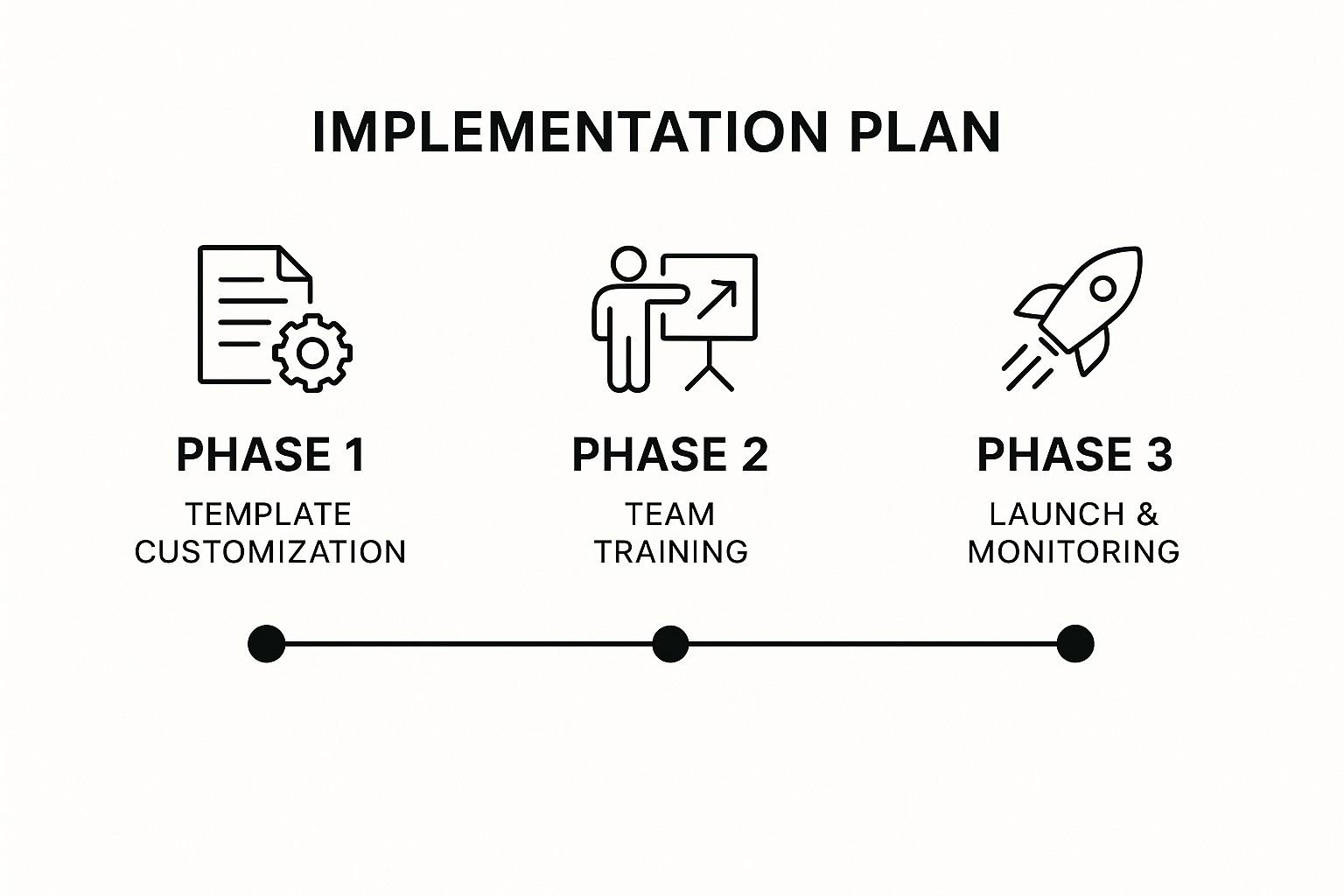Why Most Communication Templates Fail (And Yours Won't)

Let's be real: a communication strategy template shouldn't be some rigid, unchangeable document. It needs to be a living, breathing thing that adapts and evolves. I've seen so many templates just gather dust because they were designed for some imaginary perfect scenario, not the messy, ever-changing reality of actual business. In my experience, a good template can be the difference between a flawless product launch and a total PR disaster.
One of the biggest pitfalls? Templates that are just too inflexible.
Adaptability is key. Think of your communication strategy template as a well-stocked toolkit, not a set of rules carved in stone. It should empower your team to make informed decisions on the spot, whether it's a regular announcement or a sudden crisis. This means giving them guiding principles and adaptable frameworks, not rigid step-by-step instructions. Buffer, for example, is known for its transparent communication. Their template focuses on core values and adapts seamlessly to different situations.
Getting your team involved in creating the template is also essential. This not only gets them on board but also makes sure the template actually reflects their day-to-day needs. This collaborative approach avoids the template becoming just another directive from the top that everyone ignores. Think about the cost of poor communication. By 2025, ineffective communication is projected to cost businesses a staggering $1.2 trillion globally, with 86% of employees pointing to communication breakdowns as a major cause of workplace failures. Check out these eye-opening communication statistics. This really underscores the need for a communication strategy template that actually works. So, how do you create a template that avoids these common traps? Let's explore the essentials.
The Framework Elements That Actually Matter
Forget stuffy theories, let's talk practicalities. When you're up against a deadline and stakeholders are looking for answers, your communication strategy template needs to be a handy tool, not a dusty relic. Having seen countless templates from organizations that consistently nail their communication, I've noticed a few key elements that truly make a difference.
Audience Segmentation Beyond Demographics
First off, audience segmentation needs to be more sophisticated than just basic demographics. For example, imagine you're managing a company's transition to remote work. Segmenting your audience by their tech skills (rather than just their age) allows you to tailor training materials much more effectively. Or think about a product launch. Grouping your audience by their existing relationship with your brand (loyal customers vs. potential leads) will dramatically improve your messaging. You might find this helpful: EvergreenFeed's post on communication strategy plan templates. This nuanced approach avoids the generic, one-size-fits-all blasts that often fall flat.
The Power of Message Hierarchy
Another critical aspect is how you structure your message hierarchy within the template. Think of it like a well-designed website. You wouldn't cram all the information onto the homepage, right? You lead with the key takeaways and then make supporting details easily accessible. This approach avoids overwhelming your audience and ensures everyone grasps the essentials, even if they don't dive into every single detail.
The 'Failure Protocol' – Planning for the Unexpected
And here’s the real game-changer: the best templates I've seen include a "failure protocol." Let's be honest, things will go wrong. A miscommunication, a technical glitch, a sudden PR crisis… it happens. Your template should anticipate these scenarios. For instance, what if your primary communication channel goes down? Having designated alternative channels in your template can save the day. Or what if you’re faced with a common crisis scenario? Having pre-approved responses outlined in your template empowers your team to respond quickly and effectively. This is especially critical considering that 67% of leaders report underperforming transformations, often due to communication breakdowns. Including these often-overlooked elements transforms your template from a static document into a dynamic, adaptable tool.
To help illustrate this, I've put together a comparison table:
Communication Template Components Comparison
A detailed comparison of essential vs. optional template sections with implementation difficulty and impact levels
| Component | Priority Level | Implementation Difficulty | Business Impact | Time Investment |
|---|---|---|---|---|
| Audience Segmentation (Beyond Demographics) | Essential | Medium | High | Medium |
| Message Hierarchy | Essential | Low | High | Low |
| Failure Protocol | Essential | Medium | High | Medium |
| Key Message Tracking | Optional | Low | Medium | Low |
| Stakeholder Communication Log | Optional | Low | Medium | Low |
| Brand Voice Guidelines | Optional | Medium | Medium | Medium |
This table highlights the importance of the core components we've discussed. While optional elements like Key Message Tracking and Stakeholder Communication Logs can be valuable additions, the essential elements—Audience Segmentation, Message Hierarchy, and a Failure Protocol—offer the biggest bang for your buck in terms of business impact and time investment. By focusing on these key areas, you can build a truly effective communication strategy template.
Smart Channel Selection That Reaches Everyone

These days, it feels like there are a million ways to communicate, right? It's almost like having too many choices makes things harder, not easier. I've seen this happen a lot – teams trying to reach everyone, from frontline staff to the C-suite, and just ending up creating a ton of noise. The old "spray and pray" method just doesn't work anymore.
The smartest organizations are getting strategic. They're focusing on channel mapping – choosing channels that actually work together. Think about it: it's not just about where your audience is, but when they're most likely to see and absorb different types of messages.
For example, I worked with a company that used Slack for quick project updates and everyday chats, but saved email for official announcements and company-wide news. They also used SMS for urgent alerts – smart move, considering how many emails we all get every day. This targeted approach made communication clearer and helped people feel less overwhelmed. When you're building your template for communication strategy, channel selection deserves a dedicated section. Check out EvergreenFeed's guide on creating a social media plan for more channel strategy inspiration.
This is even more important now as communication strategies keep changing. By 2025, internal comms templates will be all about the multi-channel approach. This reflects how people use technology and how we can best keep employees engaged. Intranets (used by 77% of organizations, with 56% planning upgrades) and Microsoft Teams (usage is up from 51% to 63%) are leading the way. Here's a deeper dive into 2025 internal communication trends. Your template has to be flexible enough to work across these different channels.
Your communication strategy template also needs to include escalation paths. What happens when a quick Slack message needs to become a more formal video call? Having these guidelines in your template avoids confusion and makes sure important conversations happen in the right place. The real trick is finding that sweet spot: reaching people where they are without making them feel overloaded. That's the key to a successful multi-channel strategy.
Building Communication Capabilities Into Your Template

A fantastic communication strategy template is worthless if your team can't use it. So many organizations just assume everyone’s a communication whiz, and that's almost never true. The best teams actually bake communication skill development right into their templates. This means spotting capability gaps before they cause issues.
Think about it: your stakeholder management section might be perfect, but what if your team struggles with something as basic as email etiquette? Or maybe you're using fancy new AI communication tools, but some team members haven’t yet mastered clear, concise writing. Tackling these gaps directly makes a huge difference.
Here's a real-world example: I once worked with a marketing team who had a beautifully detailed crisis communication plan within their template. But when they faced a (relatively minor) product recall, their messaging was all over the place. Why? They’d never actually practiced using the template in a realistic situation.
So, what did we do? We ran a simulation. This hands-on practice showed where they struggled to adapt the template under pressure. The result? Their confidence—and their communication effectiveness—shot up after the training.
Another helpful tip: incorporate resources directly within your template. Think links to internal style guides, best practice documents for different communication channels (like social media, email, or press releases), or even quick refreshers on core communication principles. These offer just-in-time support when it’s needed most.
This focus on skills is more important than ever. Did you know 57% of global employers say communication is the most desirable skill in new hires? Here are some more interesting communication stats. This just shows how important it is to weave communication training into workforce development, and your template is the perfect place to start. Also, take a look at EvergreenFeed's post on the benefits of social media automation for ideas on streamlining your communication workflow. The best templates don't just tell you what to communicate, but how to do it well—across all kinds of situations and audiences.
Building Your Template From the Ground Up
Creating a communication strategy template that actually works requires a different approach than just handing down a list of rules. In my experience, the best templates come from understanding real-world communication problems, not some theoretical ideal. It’s like building a house – you wouldn’t start without knowing who’s going to live there, right? Your template should reflect the specific needs of the people who will be using it.
This means starting by listening, not dictating. Talk to different teams to understand their current communication workflows, what their pain points are, and what they actually need from a template. Instead of top-down presentations, run collaborative workshops. This builds buy-in and avoids the “here we go again” eye-rolls that can kill a new initiative before it even gets off the ground.
Prototyping your template with real-world scenarios is essential. Let’s say you’re launching a new product. How would the template guide the team's communication? Test it, gather feedback, and refine it. This prevents endless revisions and ensures the template is practical, not just theoretically perfect.

The infographic above provides a sample implementation plan. It shows a phased approach, starting with template customization, moving to team training, and ending with launch and monitoring. This structured rollout allows for adjustments along the way. It really emphasizes the iterative nature of template development.
To understand the timeline better, let’s take a closer look at the phases and deliverables. The table below provides a roadmap for creating your template:
To help you visualize the process, here's a practical roadmap:
Template Development Timeline and Milestones: A practical roadmap showing key phases, deliverables, and stakeholder involvement for creating an effective communication strategy template
| Phase | Duration | Key Activities | Stakeholders Involved | Success Metrics |
|---|---|---|---|---|
| Template Customization | 2 Weeks | Gather team feedback, adapt template structure & content | Communication team, key users | Template meets 80% of identified user needs |
| Team Training | 1 Week | Workshops on using the template, Q&A sessions | All relevant teams | 90% participation rate, positive feedback |
| Launch & Monitoring | Ongoing | Roll out template, collect usage data & feedback | All relevant teams | Increased template adoption, improved communication effectiveness |
This table outlines the key phases, durations, activities, stakeholders, and success metrics. It provides a practical overview of the process, enabling you to track progress and ensure alignment.
Finally, be prepared for some resistance. Some teams may have had bad experiences with previous “improvements.” Acknowledge their concerns, show them how this template is different, and highlight the benefits. This is where those initial listening sessions really prove their worth. By proactively addressing concerns, you can smooth the transition and increase adoption. Remember, change takes time. Consistent communication and support are key to making your template a success. Building a good template is a journey, not a destination.
Making Your Template Better Over Time
The best communication strategy templates aren't set in stone. They're living documents that should constantly evolve. But that evolution needs a guiding hand. Trust me, I've witnessed firsthand how a helpful template can morph into a bureaucratic nightmare if left unchecked. So, how do you keep your template relevant and useful without turning it into a burden for your team?
Gathering Feedback That Matters
Forget generic surveys. To truly improve your template, you need feedback that gets to the heart of the matter. Try running small focus groups with people who actually use the template. Even better, observe them using it in real-life situations. Ask specific questions like, "What section of the template proved most valuable during that last product launch?" or "Which parts felt cumbersome or unnecessary?" This targeted approach uncovers genuine usability issues, not just superficial complaints.
Training vs. Template Tweaks
Before you rush to revise your template, consider whether the issue stems from training gaps. Sometimes, the problem isn't the template itself, but how people are using it. For example, if your team struggles with stakeholder communication, perhaps a refresher on stakeholder mapping would be more beneficial than a template overhaul. Addressing training needs can often be a more effective solution than constant revisions. When you're just getting started with your communication strategy, leveraging existing templates can be a huge help. A solid creative brief template can ensure you're hitting all the crucial points.
Implementing Changes That Stick
When you do make changes, focus on improving real-world effectiveness, not just making cosmetic adjustments. Track key metrics like message clarity, response times, and how well you're aligning with stakeholders. These metrics reveal whether your changes are truly improving communication outcomes, not just making the template look better.
Combating Template Drift
Finally, guard against template drift – that gradual, almost imperceptible slide toward over-complication. Regularly review your template. Are there sections that have become bloated with unnecessary information? Have processes become too complex? Strive for simplicity and focus. Remember, a straightforward, user-friendly template always trumps a complex, unwieldy one. Follow these tips, and your template will remain a valuable asset, not a source of frustration.
Ready to simplify your social media scheduling and extend the reach of your evergreen content? Sign up for EvergreenFeed today! It’s free, and no credit card is required.




